Botany Exam 4
0.0(0)
Card Sorting
1/106
Earn XP
Study Analytics
Name | Mastery | Learn | Test | Matching | Spaced |
|---|
No study sessions yet.
107 Terms
1
New cards
Gymnosperm
refers to the exposed nature of the seeds; seeds produced on surface of sporophylls instead of enclosed within a fruit as in flowering plants
2
New cards
Seed
protective seed coat; supply of food for embryo; capable of dormancy in unfavorable environmental conditions
3
New cards
Pollen Grains
pollen cones produce these; consists of four cells and a pair of air sacs; air sacs add buoyancy in wind; develop from microspores
4
New cards
Nucellus
inside the female gametophyte in the ovule; enclosed in integument
5
New cards
Integument
becomes the seed coat after fertilization; surrounds the megasporangium; has a pore called micropyle
6
New cards
Pinophyta
pines, firs, spruces, cedars; most economically important phylum; contains over 100 species G
7
New cards
Ginkgophyta
has a single living representative, Ginkgo; tree with fan-shaped leaves; seeds enclosed in fleshy covering
8
New cards
Cycadophyta
leaves superficially palm-like
9
New cards
Gnetophyta
three genera; wood with vessels (only hardwood of the group)
10
New cards
Pines (Pinus)
dominant trees in coniferous forests of Northern Hemisphere; leaves needle-like and arranged in clusters of two to five leaves; cluster=fascicle; have modifications that enable them to survive harsh conditions
11
New cards
Bristlecone Pine
the world's oldest known living organisms
12
New cards
Fascicle
cluster; short shoots that have restricted growth
13
New cards
Pines: Structure and Form
hypodermis located below the epidermis, one to two layers of thick-walled cells; thick cuticle; recessed or sunken stomata; resin canals; mycorrhizal fungi associated with roots of most conifers; wood consists entirely of tracheids
14
New cards
Resin
antiseptic; prevents development of fungi; deters insects
15
New cards
Conifer wood
softwood; thick-walled cells absent
16
New cards
Broadleaf tree (dicot) wood
hardwood; thick-walled vessels and fibers present
17
New cards
Pines: Reproduction (1st type)
two kinds of spores produced; pollen cones (male strobili) consist of papery or membranous scales; microsporangia in pairs toward bases of scales (1st type); meiosis produces microspores that then develop into pollen grains; pollen grain consists of four cells and a pair of air sacs; air sacs add buoyancy in wind
18
New cards
Pines: Reproduction (2nd type)
megaspores in megasporangia within ovules; pair of ovules at bases of seed cone scales; seed cones larger than pollen cones, have woody scales with inconspicuous bracts between; ovule contains a megasporangium containing a nucellus and a single megasporocyte; megasporocyte undergoes meiosis, producing four megaspores (3 degenerate, 1 develops into the female gametophyte with archegonia at micropyle end)
19
New cards
Pines: Reproduction Cycle (1st year)
Seed cones take two years to mature
first year: pollen grains catch on sticky pollen drops oozing out of micropyle; pollen grain produces pollen tube that grows through nucellus; two sperm produced in pollen tube, mature male gametophyte=germinated pollen grain with pollen tube and two sperm, sperm have no flagella and no antheridium is formed; megaspore develops
first year: pollen grains catch on sticky pollen drops oozing out of micropyle; pollen grain produces pollen tube that grows through nucellus; two sperm produced in pollen tube, mature male gametophyte=germinated pollen grain with pollen tube and two sperm, sperm have no flagella and no antheridium is formed; megaspore develops
20
New cards
Pines: Reproduction Cycle (2nd year)
Seed cones take two years to mature
second year: female gametophyte and archegonium mature; pollen tube arrives at archegonium; one sperm unites with egg, forming zygote (other sperm degenerates); embryo nourished by female gametophyte; integument becomes seed coat
second year: female gametophyte and archegonium mature; pollen tube arrives at archegonium; one sperm unites with egg, forming zygote (other sperm degenerates); embryo nourished by female gametophyte; integument becomes seed coat
21
New cards
Yew (Taxus) and California nutmeg (Torreya)
other conifers; produce ovules singly at tips of shoots; each ovule at least partially surrounded by cuplike aril
22
New cards
Aril
fleshy nucellus found in some conifers (Yew and California nutmeg)
23
New cards
Junipers
seed cones fleshy
24
New cards
Southern Hemisphere confier
Merkus pine; Podocarpus--fleshy-coated seeds with large appendage at base
25
New cards
Phylum Ginkgophyta -- Ginkgo
maidenhair tree; only one living species and only exists in cultivation;
leaves: notched, broad, fan-shaped leaves; leaves on short, slow-growing spurs; no midrib or prominent veins; hair-like veins branch dichotomously; deciduous;
life cycle similar to pines; dioecious; seeds enclosed in fleshy seed coat with unpleasant odor
leaves: notched, broad, fan-shaped leaves; leaves on short, slow-growing spurs; no midrib or prominent veins; hair-like veins branch dichotomously; deciduous;
life cycle similar to pines; dioecious; seeds enclosed in fleshy seed coat with unpleasant odor
26
New cards
Dioecious
male and female structures on separate trees
27
New cards
Phylum Cycadophyta -- The Cycads
slow-growing plants of tropics and subtropics; tall unbranched trunks; crown of large pinnately divided leaves; life cycle similar to conifers: pollination sometimes by beetles, dioecious, has pollen and seed strobili
28
New cards
Phylum Gnetophyta -- The Gnetophytes
unique among the gymnosperms in having vessels in the xylem; joint firs (Ephedra) - shrubby plants of drier regions of southwestern North America; Gnetum - vine-like plants with broad leaves in tropics; Welwitschia - only one species, confined to deserts of southwestern Africa, short stem and long taproot, only two straplike leaves that become tattered and split, dioecious, has male and female strobili
29
New cards
Pine Life Cycle
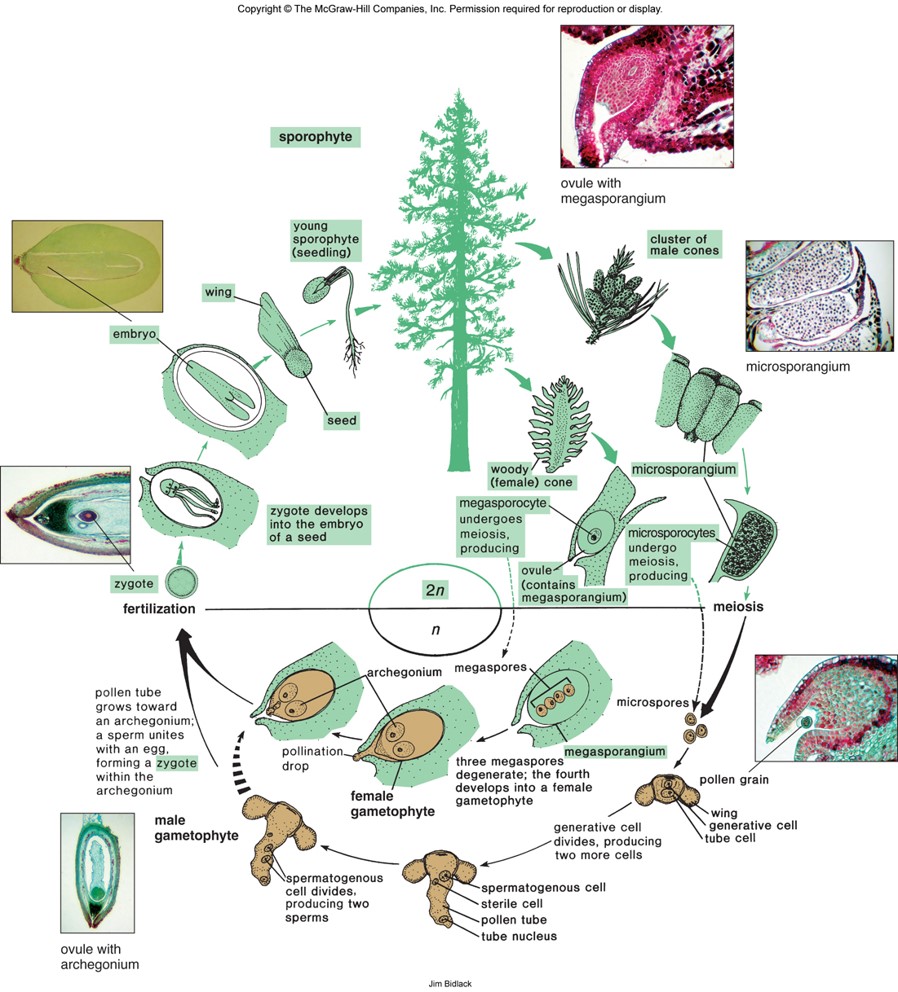
30
New cards
Angiosperms
flowering plants (vessel seed)
31
New cards
Carpel
encloses seed
32
New cards
Pistil
composed of a single carpel, or two or more united carpals
33
New cards
Ovule vs Ovary
seed develops from ovule within carpel; ovary becomes the fruit
34
New cards
Heterosporous
produces microspores (male) and megaspores (female)
35
New cards
Phylum Magnoliophyta -- the Flowering Plants
heterosporous; sporophytes dominant; female gametophytes wholly enclosed within sporophyte tissue and reduced to only a few cells; at maturity, male gametophytes consist of a germinated pollen grain with three nuclei
36
New cards
Development of the female gametophyte in Phylum Magnoliophyta
diploid megasporocyte differentiates in ovule; outer two layers of ovule differentiate into integuments that later become the seed coat; micropyle at one end of the ovule; 8 nuclei form two groups, four near each end of the cell; one nucleus from each group migrates to cell middle and forms central cell; cell walls form around remaining six nuclei--egg and two synergids closest to micropyle; three antipodals at opposite
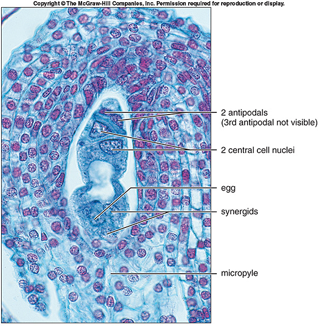
37
New cards
Megasporocyte in Phylum Magnoliophyta
diploid; differentiates in ovule; undergoes meiosis and produces 4 haploid megaspores, 3 of which degenerate and the remaining cell enlarges and nucleus divides to produce 8 nuclei (without walls)
38
New cards
Female gametophyte of phylum magnoliophyta
megagametophyte, embryo sac; large sac containing 8 nuclei and 7 cells
39
New cards
Development of the male gametophyte in Phylum Magnoliophyta
formation takes place in anthers; four patches, corresponding to pollen sacs, of microsporocyte cells differentiate in anther; each microsporocyte undergoes meiosis to produce quartet of haploid microspores; microspores undergo three important changes (see other flashcard); generative nucleus will later divide to produce two sperm
40
New cards
Three important changes of the microspores of male gametophytes in phylum magnoliophyta
1. divide once by mitosis to form a small generative cell inside the larger tube cell; nucleus of tube cell = vegetative nucleus
2. members of each quartet of microspores separate
3. wall becomes two-layered; outer layer = exine--finely sculptured, contains chemicals that may react with chemicals in stigma
2. members of each quartet of microspores separate
3. wall becomes two-layered; outer layer = exine--finely sculptured, contains chemicals that may react with chemicals in stigma
41
New cards
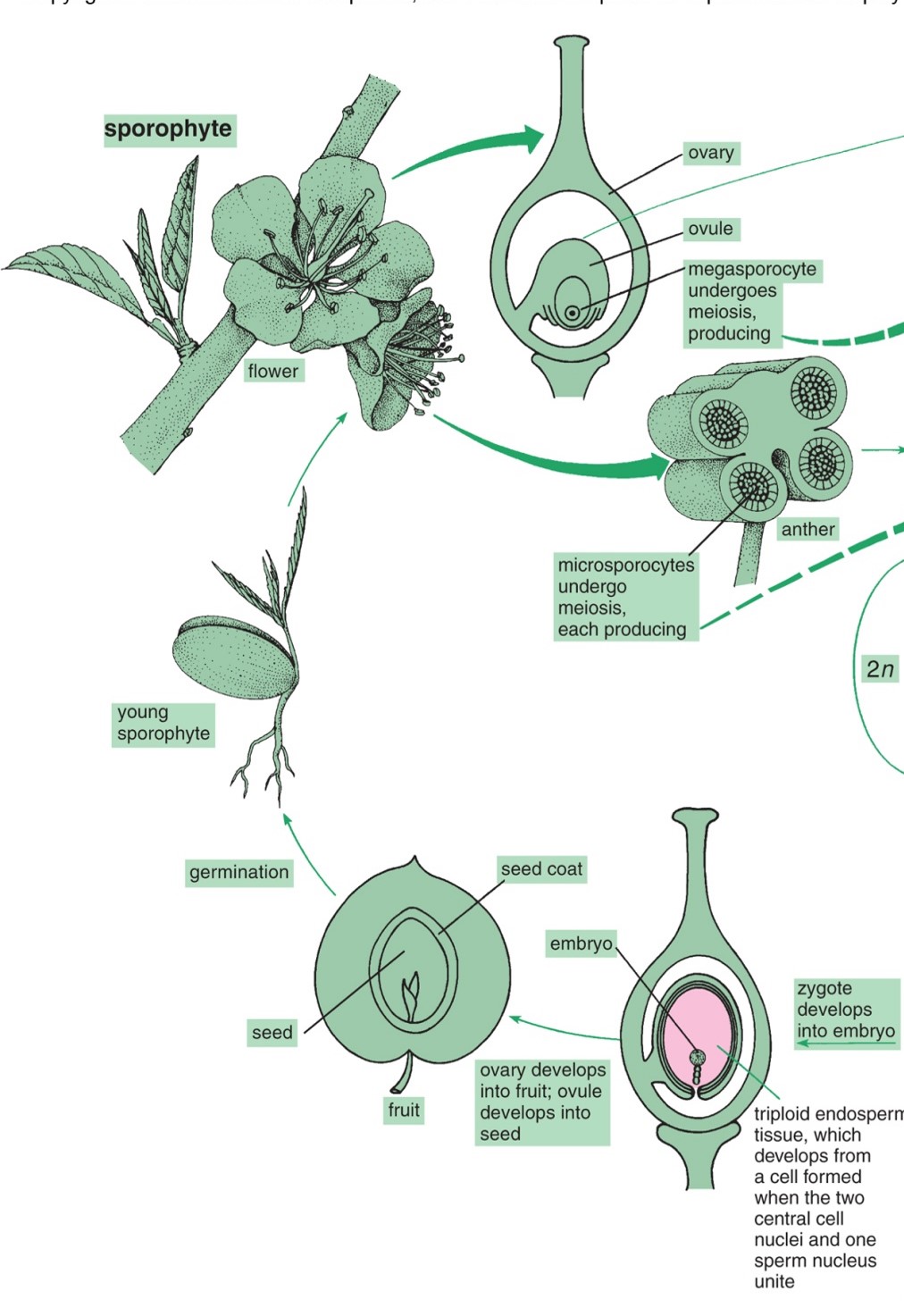
Life Cycle of Phylum Magnoliophyta
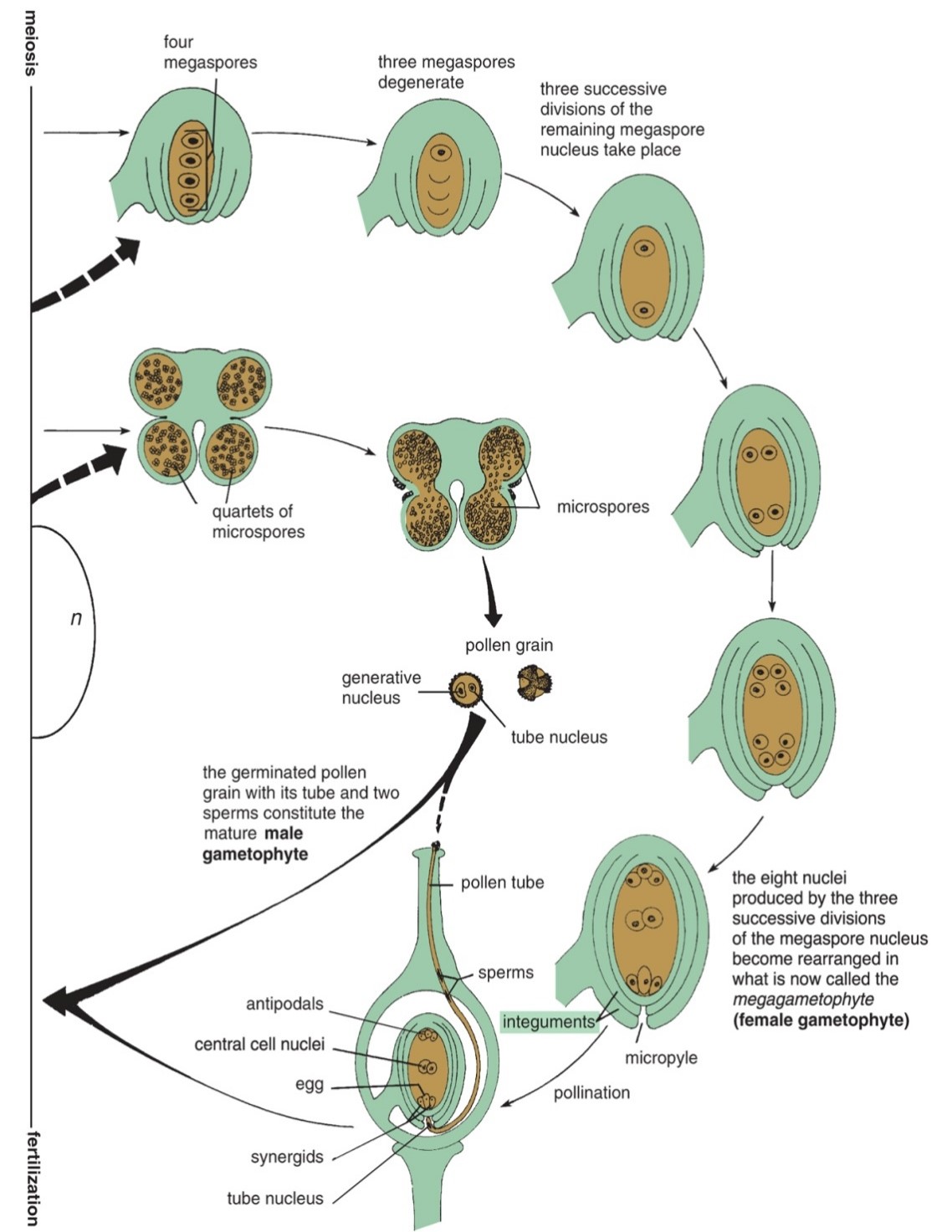
42
New cards
Pollination
transfer of pollen grains from anther to stigma;
self-pollination: pollen grains germinate on stigma of same flower; pollination by insects, wind, water, animals, or gravity
self-pollination: pollen grains germinate on stigma of same flower; pollination by insects, wind, water, animals, or gravity
43
New cards
Fertilization
Union of sperm and egg
44
New cards
fertilization and development of the seed in phylum magnoliophyta
after pollination, further development of male gametophyte may not take place unless the pollen grain is a) from a different plant of the same species and b) from a variety different from that of the receiving flower; pollen tube grows between cells of stigma and style until it reaches ovule micropyle; vegetative nucleus stays at tips of pollen tube while generative cell lags behind and divides into two sperm; pollen tube enters female gametophyte, destroying synergid in the process, and discharges sperms
45
New cards
Mature male gametophyte in Phylum Magnoliophyta
germinated pollen grain with its vegetative nucleus and two sperms within tube cell

46
New cards
Double fertilization
one sperm unites with egg, forming zygote, then embryo; other sperm unites with central cell nuclei producing triploid endosperm nucleus that develops into endosperm tissue; endosperm becomes extensive part of seed in some monocots such as corn and other grasses; endosperm absorbed into cotyledons in most dicots
47
New cards
Endosperm tissue
nutritive tissue for embryo
48
New cards
Apomixis
without fusion of gametes but with the normal structures otherwise being involved; embryo may develop from diploid nutritive cell (2x) or other diploid cell of ovule, instead of from zygote; results in a vegetatively propagated plant
49
New cards
Parthenocarpy
fruits develop from ovaries with unfertilized eggs; results in seedless fruits (ex: navel oranges and bananas)
50
New cards
Superior ovary (hypogynous flower)
ovary produced on top of receptacle; other flower parts attached around ovary base
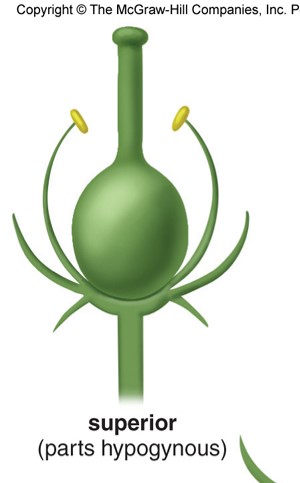
51
New cards
Superior ovary (perigynous flower)
flower parts attached to corolla tube of fused petals, creating floral tube that is not attached to ovary
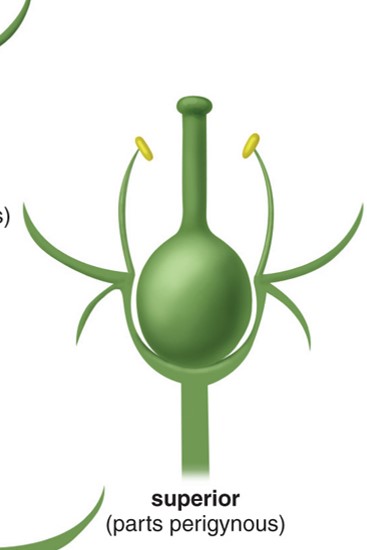
52
New cards
Inferior ovary (epigynous flower)
receptacle or other flower parts fused to ovary and grown up around it; calyx and corolla appear to be attached to top of ovary
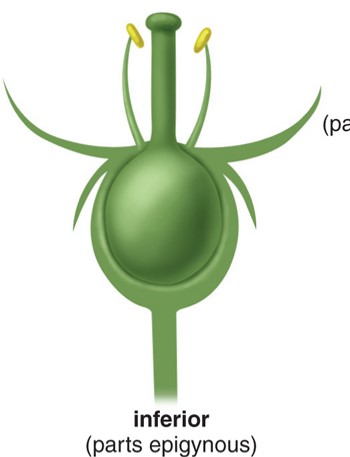
53
New cards
Complete flower
has calyx, corolla, stamens, and pistil
54
New cards
Incomplete flower
corolla or other flower parts missing
55
New cards
Perfect flower
both stamens and pistil present
56
New cards
Imperfect flower
either stamens or pistil missing; monoecious and dioecious species
57
New cards
Imperfect flower: monoecious species
male and female imperfect flowers on the same plant
58
New cards
Imperfect flower: dioecious species
plant bears only male flowers and other plants bear only female flowers
59
New cards
Bee-pollinated flowers
COLOR:
generally brightly colored, mostly blue or yellow; often have lines or other distinctive markings which may function as honey guides to lead bees to nectar; bees see UV light (humans do not)
generally brightly colored, mostly blue or yellow; often have lines or other distinctive markings which may function as honey guides to lead bees to nectar; bees see UV light (humans do not)
60
New cards
Beetle-pollinated flowers
ODOR:
strong, yeasty, spicy, or fruity odor; white or dull in color because beetles do not have keen visual senses; some do not secrete nectar, but furnish pollen or food on petals in special storage cells
strong, yeasty, spicy, or fruity odor; white or dull in color because beetles do not have keen visual senses; some do not secrete nectar, but furnish pollen or food on petals in special storage cells
61
New cards
Fly-pollinated flowers
ODOR:
smell like rotten meat; dull red or brown
smell like rotten meat; dull red or brown
62
New cards
Butterfly- and moth-pollinated flowers
FRAGRANCE:
often have sweet fragrances; white or yellow for night-flying moths; sometimes red, often blue, yellow, or orange for butterflies; nectaries at bases of corolla tubes or spurs for long tongues
often have sweet fragrances; white or yellow for night-flying moths; sometimes red, often blue, yellow, or orange for butterflies; nectaries at bases of corolla tubes or spurs for long tongues
63
New cards
Bird-pollinated flowers
hummingbirds and sunbirds; often bright red or yellow; little if any odor because birds do not have a keen sense of smell; large and part of sturdy inflorescence; copious amounts of nectar because birds are highly active; long floral tubes
64
New cards
Bat-pollinated flowers
primarily in tropics; open at night when bats are foraging; dull in color; large enough for bat to insert head or consist of ball-like inflorescence containing large numbers of small flowers
65
New cards
Orchid flowers
have pollinators among all types mentioned; some extraordinary adaptations; pollen grains produced in little sacs called pollinia with sticky pads at base; members of Ophrys have modified petal that resembles female bumble bee or wasp--male bees/wasps attracted to flower, pollinia deposited on their head
66
New cards
Herbaria
singular: herbarium; libraries of dried, pressed plants, algae, and fungi arranged and labeled
67
New cards
Methods of Plant Preservation
fungi and bryophytes dried and stored in small packets; plant press used for vascular plants; vascular plant specimens mounted on herbarium paper; specimens stored so retrieval of specimens is easily accomplished
68
New cards
Class Magnoliopsida
dicot class of phylum magnoliophyta
69
New cards
Class Liliopsida
monocot class of phylum magnoliophyta
70
New cards
Alphonse de Candolle
wrote "Origin of Cultivated Plants" in the 1880's; cultivated plants originated in areas where wild relatives grow
71
New cards
N. I. Vavilov
1916; plants were domesticated in geographic regions with high genetic diversity of wild relatives; majority of domesticated plants originated from mountainous regions
72
New cards
Jack Harlan
1950's; associated crop origins with regions
73
New cards
Six major regions of plant origins
near-eastern region, Chinese region, African region, South Asia and Pacific Islands, North America, South and Central America
74
New cards
Near-eastern region
Mediterranean, northern Europe; barley, wheat, peas, lentils, asparagus, beets, carrots, turnips, olives, cherries, plums, apricots, apples, onions, garlic, broccoli, lettuce, flax, pistachios
75
New cards
Chinese region
temperate and southern China; bamboo, peach, walnut, ginger, gourds, camphor, tea, soybean, buckwheat, horseradish, cucumber
76
New cards
African continent
mostly Ethiopia and West Africa; yams, sorghum, okra, sweet melons, coffee, some cotton
77
New cards
South Asia and Pacific Islands
sugar cane, eggplant, mango, banana, citrus, safflower, nutmeg, clove, cardamom, turmeric, black pepper, coconut, taro, rice, sesame, onion
78
New cards
North America
sunflower, cranberry, blueberry, tobacco
79
New cards
South and Central America
garden beans, corn, peanut, white potato, lima beans, cashew, pineapple, avocado, red pepper, tomato, cotton, cacao (chocolate), sweet potato, pumpkin, squash, rubber, vanilla, cassava
80
New cards
Dicot families
buttercup, laurel, poppy, mustard, rose, legume, spurge, cactus, mint, nightshade, carrot, pumpkin, sunflower
81
New cards
Monocot families
grass, lily, and orchid
82
New cards
The Buttercup Family -- Ranunculaceae
dicot; nearly all 1500 species are herbaceous; petal vary in number; numerous stamens; several to many pistils with superior ovaries;
*concentrated in north temperate and arctic regions; most at least slightly poisonous*
*concentrated in north temperate and arctic regions; most at least slightly poisonous*
83
New cards
The Laurel Family -- Lauraceae
dicot; about 1000 species of tropical evergreen shrubs and trees; no petals but sepals sometimes petal-like; stamens in three or four whorls (anthers open by flaps that lift up);
*cinnamon, cassia, camphor, sassafras trees, sweet bay, avocado*
*cinnamon, cassia, camphor, sassafras trees, sweet bay, avocado*
84
New cards
Cinnamon
lauraceae, laurel family; pulverized bark of small tree
85
New cards
Cassia
lauraceae, laurel family; east asian evergreen bark (like cinnamon)
86
New cards
Camphor
lauraceae, laurel family; cold remedies, insecticides
87
New cards
Sassafras trees
lauraceae, laurel family; native to eastern U.S.
88
New cards
Sweet Bay
lauraceae, laurel family; flavoring in meat dishes
89
New cards
The Poppy Family -- Papaveraceae
dicot; herbs of temperate and subtropical regions; numerous stamens, but single pistil; milky or colored sap; opium poppies: opium-white fluid from capsules, morphine and codeine-heroin, papaverine and noscapine, poppy seeds;
*all species produce alkaloidal drugs*
*all species produce alkaloidal drugs*
90
New cards
The Mustard Family -- Brassicaceae
dicot; nearly all 2500 species in temperate and cooler regions of North America; four flower petals arranged in a cross; six stamen--2 short and 4 long; fruits = siliques or silicles; all produce pungent watery juice;
*many cultivated edible plants*
*many cultivated edible plants*
91
New cards
Cultivated edible plants of the mustard family
(brassicaceae) cauliflower, brussels sprouts, broccoli, radish, turnip, horseradish, watercress, rutabaga; Mustard -- ground seeds of two species of Brassica
92
New cards
The Rose Family -- Rosaceae
dicot; more than 3000 species of trees, shrubs, and herbs; flowers have basal parts fused into cup with petals, sepals, and numerous stamens attached to the cup's rim; family subdivided into subfamilies on basis of flower structure and fruits;
*enormous economic impact*
*enormous economic impact*
93
New cards
Economic impact of the rose family
(rosaceae) stone fruits: cherries, apricots, peaches, plums
pome fruits: apples, pears
aggregate fruits: strawberries, blackberries, raspberries
garden ornamentals: roses
fragrances
fruits of roses = hips -- Vitamin C
pome fruits: apples, pears
aggregate fruits: strawberries, blackberries, raspberries
garden ornamentals: roses
fragrances
fruits of roses = hips -- Vitamin C
94
New cards
The Legume Family -- Fabaceae
*third largest of flowering plant families with 13,000 species*
dicot; cosmopolitan-grows globally in many diverse environments; flowers radial to bilateral; stamens fused into tube around ovary; fruit is a legume; important crop plants: peas, beans, soybeans, peanuts, alfalfa, sweet clover, licorice, carob
*fix nitrogen from the air*
dicot; cosmopolitan-grows globally in many diverse environments; flowers radial to bilateral; stamens fused into tube around ovary; fruit is a legume; important crop plants: peas, beans, soybeans, peanuts, alfalfa, sweet clover, licorice, carob
*fix nitrogen from the air*
95
New cards
The Spurge Family -- Euphorbiaceae
dicot; in tropical and temperate regions; several economically important plants: *cassava--staple food in tropical regions, *para rubber tree--crude rubber from latex of inner bark; stamens and pistils produced in separate flowers; flowers often inconspicuous and lack corolla (ex poinsettia)
96
New cards
The Cactus Family -- Cactaceae
dicot; more than 1500 species **native only to Americas** in dry, subtropical regions; leaves reduced in size, often spines; fleshy stems
97
New cards
The Mint Family -- Lamiaceae
dicot; 3000 species; unique combination of angular stems, **square in cross section**, opposite leaves, bilaterally symmetrical flowers; ovary superior and four-parted developing into four nutlets; plants produce mint oils which are used medicinally and as antiseptic
98
New cards
Mint Oils
(lamiaceae) rosemary, thyme, sage, oregano, marjoram, basil, lavender, catnip, peppermint, spearmint
99
New cards
The Nightshade Family -- Solanaceae
dicot; 3000 species concentrated in tropics of central and south america; flowers have fused petals with stamens fused to corolla; superior ovary develops into berry or capsule;
*food: tomato, white potato, eggplant, peppers, tobacco, petunia*
*food: tomato, white potato, eggplant, peppers, tobacco, petunia*
100
New cards
Poisonous Nightshades
many nightshades are poisonous, several have medicinal properties; belladonna drug complex: atropine-shock treatment and pain relief, scopolamine-tranquilizer; capsicum from red pepper-gastric stimulant; jimson weed-asthma; tobacco